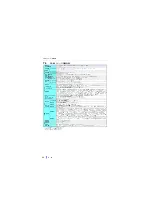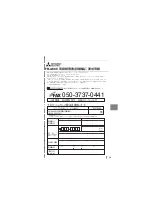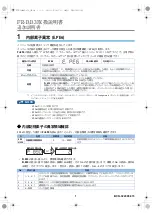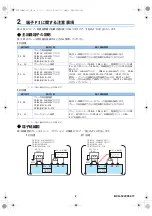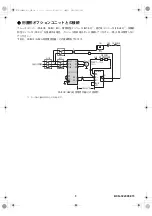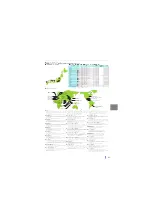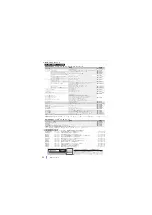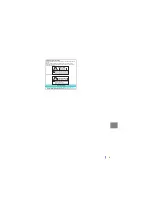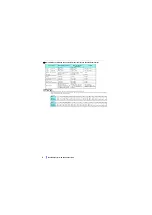
2
Fire Prevention
Injury Prevention
Additional Instructions
The following instructions must be also followed. If the product
is handled incorrectly, it may cause unexpected fault, an injury,
or an electric shock.
CAUTION
The inverter must be installed on a nonflammable wall without holes in it
so that its components cannot be touched from behind. Installing it on or
near flammable material may cause a fire.
If the inverter becomes faulty, the inverter power must be switched OFF. A
continuous flow of large current may cause a fire.
When using a brake resistor, a sequence that will turn OFF power when a
fault signal is output must be configured. Otherwise the brake resistor
may excessively overheat due to damage of the brake transistor and
such, causing a fire.
Do not connect a resistor directly to the DC terminals P/+ and N/-. Doing
so could cause a fire.
Be sure to perform daily and periodic inspections as specified in the
Instruction Manual. There is a possibility of explosion, damage, or fire if
this product is used without inspection.
CAUTION
The voltage applied to each terminal must be the ones specified in the
Instruction Manual. Otherwise an explosion or damage may occur.
The cables must be connected to the correct terminals. Otherwise an
explosion or damage may occur.
The polarity (+ and -) must be correct. Otherwise an explosion or damage
may occur.
While power is ON or for some time after power-OFF, do not touch the
inverter as it will be extremely hot. Touching these devices may cause
burns.
CAUTION
Transportation and installation
Since the inverter is non-explosion-proof, always install it in a non-
hazardous place.
To prevent injury, wear cut-resistant gloves when opening packaging with
sharp tools.
Use proper lifting techniques or a trolley when carrying products. Failure
to do so may lead to injuries.
Do not stand or rest heavy objects on the product.
Do not stack the boxes containing inverters higher than the number
recommended.
When carrying the inverter, do not hold it by the front cover; It may fall or
break.
During installation, caution must be taken not to drop the inverter as doing
so may cause injuries.
The product must be installed on a surface that withstands the weight of
the inverter.
Do not install the product on a hot surface.
Ensure the mounting orientation of this product is correct.
The inverter must be installed on a strong surface securely with screws so
that it will not drop.
Do not install or operate the inverter if it is damaged or has parts missing.
Foreign conductive objects must be prevented from entering the inverter.
That includes screws and metal fragments or other flammable substance
such as oil.
As the inverter is a precision instrument, do not drop or subject it to
impact.
The surrounding air temperature must be between -10 and +50°C (non-
freezing). Otherwise the inverter may be damaged.
The ambient humidity must be 95%RH or less (non-condensing).
Otherwise the inverter may be damaged. (Refer to
for details.)
The storage temperature (applicable for a short time, e.g. during transit)
must be between -20 and +65°C. Otherwise the inverter may be
damaged.
The inverter must be used indoors (without corrosive gas, flammable gas,
oil mist, dust and dirt etc.) Otherwise the inverter may be damaged.
The inverter must be used at an altitude within 2500 m or less, within 5.9
m/s
2
vibration at 10 to 55 Hz in X, Y, and Z directions. Otherwise the
inverter may be damaged. (For installation at an altitude above 1000 m,
consider a 3% reduction in the rated current per 500 m increase in
altitude.)
If halogens (including fluorine, chlorine, bromine, and iodine) contained in
fumigants for wood packages enter this product, the product may be
damaged. Prevent the entry of fumigant residuals or use an alternative
method such as heat disinfection. Note that sterilization or disinfection of
wood packages should be performed before packing the product.
To prevent a failure, do not use the inverter with a part or material
containing halogen flame retardant including bromine.
Wiring
Do not install a power factor correction capacitor, surge absorber, or radio
noise filter on the output side of this product. These devices may overheat
or burn out.
The output side terminals (terminals U, V, and W) must be connected
correctly. Otherwise the motor will rotate inversely.
Test operation
For the FR-B3 series, operate with Advanced magnetic flux vector control
after performing offline auto tuning.
Before starting operation, each parameter must be confirmed and
adjusted. A failure to do so may cause some machines to make
unexpected motions.
WARNING
Usage
Since this inverter is used in combination with the Mitsubishi Electric
inverter-driven, pressure-resistant, explosion-proof motor, note the driven
motor used with the inverter.
Since this inverter assumes to be used in combination with the Mitsubishi
Electric inverter-driven pressure-resistant explosion-proof type motors,
settings are restricted for some parameters. Always use the parameters
under restrictions.
Note that this inverter cannot be used with the Mitsubishi Electric
increased-safety, explosion-proof motor.
Everyone must stay away from the equipment when the retry function is
set as it will restart suddenly after a trip.
Since pressing the STOP/RESET key may not stop output depending on
the function setting status, separate circuit and switch that make an
emergency stop (power OFF, mechanical brake operation for emergency
stop, etc.) must be provided.
OFF status of the start signal must be confirmed before resetting the
inverter fault. Resetting inverter fault with the start signal ON restarts the
motor suddenly.
Use this inverter only with three-phase induction motors. Connection of
any other electrical equipment to the inverter output may damage the
equipment.
Do not modify the equipment.
Do not perform parts removal which is not instructed in this manual. Doing
so may lead to fault or damage of the product.
CAUTION
Usage
The electronic thermal relay function does not guarantee protection of the
motor from overheating. It is recommended to install both an external
thermal and PTC thermistor for overheat protection.
Do not repeatedly start or stop this product with a magnetic contactor on
its input side. Ding so may shorten the life of this product.
The effect of electromagnetic interference must be reduced by using a
noise filter or by other means. Otherwise nearby electronic equipment
may be affected.
Appropriate precautions must be taken to suppress harmonics. Otherwise
power supply harmonics from the inverter may heat/damage the power
factor correction capacitor and generator.
When parameter clear or all parameter clear is performed, the required
parameters must be set again before starting operations because all
parameters return to their initial values.
The inverter can be easily set for high-speed operation. Before changing
its setting, the performances of the motor and machine must be fully
examined.
Stop status cannot be held by the inverter's brake function. In addition to
the inverter’s brake function, a holding device must be installed to ensure
safety.
Before running an inverter which had been stored for a long period,
inspection and test operation must be performed.
Static electricity in your body must be discharged before you touch the
product.
Emergency stop
A safety backup such as an emergency brake must be provided for
devices or equipment in a system to prevent hazardous conditions in case
of failure of this product or an external device controlling this product.
When the breaker on the inverter input side trips, the wiring must be
checked for fault (short circuit), and internal parts of the inverter for a
damage, etc. The cause of the trip must be identified and removed before
turning ON the power of the breaker.
When a protective function activates, take an appropriate corrective
action, then reset the inverter, and resume the operation.
Maintenance, inspection and parts replacement
Do not carry out a megger (insulation resistance) test on the control circuit
of the inverter. It will cause a failure.
Disposal
The inverter must be treated as industrial waste.


